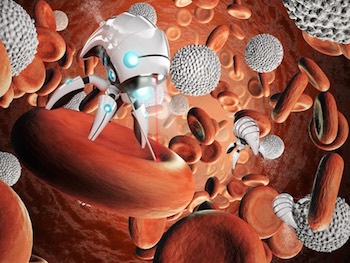 In the 1966 science fiction movie Fantastic Voyage, a team of scientists and U.S. government agents are shrunk to a microscopic size in order to travel within a human body in a ship called the Proteus. Their task is to remove a blood clot threatening the life of a comatose scientist named Dr. Benes whose mind holds a secret that could tip the scales of the Cold War, but they only have an hour before returning to normal size. The team traverses the heart, lungs, ears and other organs of the body as the film hypothesizes upon how tough life inside the human body can be to survive. Interestingly, famed writer Isaac Asimov only wrote the novelization of the screenplay and didn’t conceive the story idea himself but some have noted that he did add touches for scientific accuracy, such as explaining the fate of the Proteus and how it didn’t kill Dr. Benes by returning to its regular size.
In the 1966 science fiction movie Fantastic Voyage, a team of scientists and U.S. government agents are shrunk to a microscopic size in order to travel within a human body in a ship called the Proteus. Their task is to remove a blood clot threatening the life of a comatose scientist named Dr. Benes whose mind holds a secret that could tip the scales of the Cold War, but they only have an hour before returning to normal size. The team traverses the heart, lungs, ears and other organs of the body as the film hypothesizes upon how tough life inside the human body can be to survive. Interestingly, famed writer Isaac Asimov only wrote the novelization of the screenplay and didn’t conceive the story idea himself but some have noted that he did add touches for scientific accuracy, such as explaining the fate of the Proteus and how it didn’t kill Dr. Benes by returning to its regular size.
The use of microscopic electronics in medicine has been trying to make the leap from literature to real life for some time now. The U.S. Food and Drug Administration (FDA) approved the first nano-drug, a cancer treatment marketed as Doxil, back in 1995. Since that time, however, only about 30 nanoparticle drugs have entered the U.S. market since that time. High research and development costs and increased technical difficulties compared to other pharmaceuticals have proven to be difficult obstacles to hurdle. Yet the prospects of the benefits of targeted drug delivery at a cellular level, or advanced monitoring for potential health issues, keeps researchers focused on the technology.
Recently, a research team representing a pair of European universities achieved a breakthrough in nanoscale medical machines, which could potentially be deployed within the human body. Scientists from the Swiss academic institutions École Polytechnique Fédérale de Lausanne (EPFL) and the Eidgenössische Technische Hochschule Zürich (ETHZ) have built microrobots capable of mimicking the movement of bacteria. The microrobots are composed of magnetic nanoparticles covered by layers of a biocompatible hydrogel. Manufacturing the microrobots involves applying electromagnetic fields and a polymerization step, which solidifies the hydrogel. Finally, the microrobot is placed into water where it folds into shape based upon the orientation of the nanoparticles. In its activity, the microrobot mimics the behavior of African trypanosomiasis, the bacteria which causes sleeping sickness. The breakthrough enables researchers to test a variety of microrobot configurations to see which are best to achieve jobs like drug delivery or internal surgical procedures.
Controlling the movement of microrobots is a research goal which has consumed the focus of scientists on both sides of the Atlantic. An engineering team at Philadelphia’s Drexel University recently developed a new method for directing microrobot movement within the body. The small robots used by the team included a computer chip coated with flagellated bacteria. Using Serratia marcescens bacterium, a pathogen from the human gastrointestinal system, the team found that they could control the microrobot’s movements across an electric field; this is possible because S. marcescens has a negative charge. The engineering team created a control algorithm which allows the microrobot to steer itself according to deformations in the electric field. The algorithm incorporates data from a microscope-mounted camera to develop the microrobot’s route.
Researchers at Harvard University’s Wyss Institute for Biologically Inspired Engineering have been working on developing nanorobots derived from human DNA which could deliver molecular instructions to targeted cells. The programmable nanorobot is constructed by folding DNA strands into a barrel-like configuration which can hold molecular payloads. The barrel opens when the nanorobot detects a cell or cell-surface protein combinations, releasing antibody fragments containing molecular instructions. The use of the DNA nanorobot to send self-destruct instructions to cancerous cells has been proposed but the programmable nature of the nanorobot indicates that it could be used in a range of treatments.
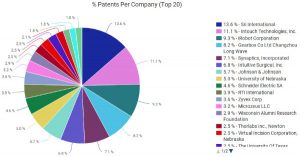 A survey of U.S. patents related to microrobots using the analysis tools provided by Innography shows us that the non-profit research institute SRI International of Menlo Park, CA, has the leading position in this market with 13.6 percent of the U.S. patents in this sector. Telehealth provider InTouch Technologies of Goleta, CA, is second-place with 11.1 percent of the U.S. patents related to microrobots and the Belford, MA-based advanced tech firm iRobot Corporation (NASDAQ:IRBT) is in third place with 9.3 percent.
A survey of U.S. patents related to microrobots using the analysis tools provided by Innography shows us that the non-profit research institute SRI International of Menlo Park, CA, has the leading position in this market with 13.6 percent of the U.S. patents in this sector. Telehealth provider InTouch Technologies of Goleta, CA, is second-place with 11.1 percent of the U.S. patents related to microrobots and the Belford, MA-based advanced tech firm iRobot Corporation (NASDAQ:IRBT) is in third place with 9.3 percent.
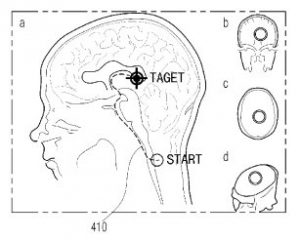 A couple of intriguing technologies related to the use of microrobots for medical treatments have been patented by South Korea’s Chonnam National University. U.S. Patent No. 8862205, titled Therapeutic Microrobot System for Brain and Spinal Cord Diseases, claims a microrobot system having a driving unit with a magnet and a drug delivery means for treating a disease lesion. The microrobot system also has a driving module to control microrobot motions through the generation of electromagnetic force, an imaging module to produce 3D images from X-rays and a diagnosis module which can diagnose the brain or spinal cord disease based on the image generated by the imaging module. The resulting innovation provides a treatment option for brain and spinal cord disease patients who would otherwise require brain surgery involving a shunt operation, which is highly invasive.
A couple of intriguing technologies related to the use of microrobots for medical treatments have been patented by South Korea’s Chonnam National University. U.S. Patent No. 8862205, titled Therapeutic Microrobot System for Brain and Spinal Cord Diseases, claims a microrobot system having a driving unit with a magnet and a drug delivery means for treating a disease lesion. The microrobot system also has a driving module to control microrobot motions through the generation of electromagnetic force, an imaging module to produce 3D images from X-rays and a diagnosis module which can diagnose the brain or spinal cord disease based on the image generated by the imaging module. The resulting innovation provides a treatment option for brain and spinal cord disease patients who would otherwise require brain surgery involving a shunt operation, which is highly invasive.
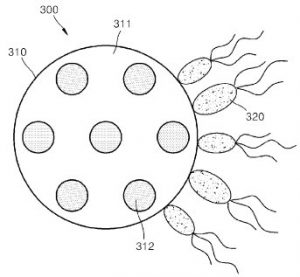 Chonnam also holds a patent protecting a microrobot technology which is very similar to those developed at other universities in U.S. Patent No. 8951242, titled Bacterium-Based Microrobot Including Magnetic Particles. It claims a bacterium-based microrobot with a microstructure having a core containing a drug and a shell composed of biodegradable polymer. The core also contains magnetic particles having a diameter of five nanometers (nm) to 500 nm dispersed throughout the core. The bacteria are selectively attached to a hydrophobic, or water-repellant, surface of the microstructure which is hemispheric and can be modified to be either hydrophobic or hydrophilic, attracting water. This innovation takes advantage of bacteria’s ability to sense diseased parts and move within a patient’s body.
Chonnam also holds a patent protecting a microrobot technology which is very similar to those developed at other universities in U.S. Patent No. 8951242, titled Bacterium-Based Microrobot Including Magnetic Particles. It claims a bacterium-based microrobot with a microstructure having a core containing a drug and a shell composed of biodegradable polymer. The core also contains magnetic particles having a diameter of five nanometers (nm) to 500 nm dispersed throughout the core. The bacteria are selectively attached to a hydrophobic, or water-repellant, surface of the microstructure which is hemispheric and can be modified to be either hydrophobic or hydrophilic, attracting water. This innovation takes advantage of bacteria’s ability to sense diseased parts and move within a patient’s body.
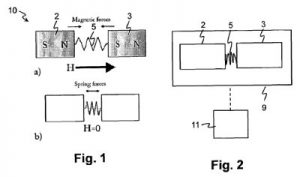 ETHZ, one of the Swiss universities involved in the recent microbot breakthrough, received a patent in 2013 for a related technology. U.S. Patent No. 8405256, entitled Wireless Resonant Magnetic Actuation for Untethered Microrobots, claims a wireless resonant micro-actuator having at least two magnetic bodies connected to each other with a resilient member to form a spring-mass system, a magnetic field generator which creates a magnetic force to wirelessly power the spring-mass system and a converter which converts oscillatory motion of the two magnetic bodies into useful motion for the untethered microrobot. This innovation addresses issues in propulsion systems for microrobots which are incapable of creating effective propulsion for an untethered microrobot.
ETHZ, one of the Swiss universities involved in the recent microbot breakthrough, received a patent in 2013 for a related technology. U.S. Patent No. 8405256, entitled Wireless Resonant Magnetic Actuation for Untethered Microrobots, claims a wireless resonant micro-actuator having at least two magnetic bodies connected to each other with a resilient member to form a spring-mass system, a magnetic field generator which creates a magnetic force to wirelessly power the spring-mass system and a converter which converts oscillatory motion of the two magnetic bodies into useful motion for the untethered microrobot. This innovation addresses issues in propulsion systems for microrobots which are incapable of creating effective propulsion for an untethered microrobot.

![[IPWatchdog Logo]](https://ipwatchdog.com/wp-content/themes/IPWatchdog%20-%202023/assets/images/temp/logo-small@2x.png)

![[Advertisement]](https://ipwatchdog.com/wp-content/uploads/2024/04/Patent-Litigation-Masters-2024-sidebar-700x500-1.jpg)

![[Advertisement]](https://ipwatchdog.com/wp-content/uploads/2021/12/WEBINAR-336-x-280-px.png)
![[Advertisement]](https://ipwatchdog.com/wp-content/uploads/2021/12/2021-Patent-Practice-on-Demand-recorded-Feb-2021-336-x-280.jpg)
![[Advertisement]](https://ipwatchdog.com/wp-content/uploads/2021/12/Ad-4-The-Invent-Patent-System™.png)






Join the Discussion
No comments yet.